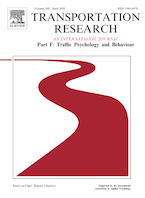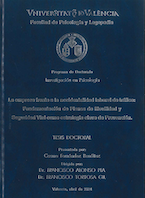Resultats de la cerca67 resultats
-

ICSC 2024
Sergio Useche, Nagahiro Yoshida, Francisco Alonso, Javier Gene
(2024). Participació en congressos"From Japan to the world… on two wheels": Comparing self-reported behavioral data of Japanese cyclists with current global trends Investigadors de l'INTRAS participen al 12th International Cycling Safety Conference, que se celebra del 5 al 7 de novembre de 2024 a Imabari (Japó) La missió de la comunitat International Cycling Safety (ICS) és millorar la seguretat ciclista a través del treball científic. La comunitat ICS pretén difondre els resultats científics a totes les parts interessades a la seguretat ciclista. Les conferències anuals de l'ICS ofereixen un fòrum de primer ordre per compartir resultats científics i afavorir la creació de xarxes dins de la comunitat ICS. Tema de l'ICSC...
"From Japan to the world… on two wheels": Comparing self-reported behavioral data of Japanese cyclists with current global trends Investigadors de l'INTRAS participen al 12th International Cycling Safety Conference, que se celebra del 5 al 7 de novembre de 2024 a Imabari (Japó) La missió de la comunitat International Cycling Safety (ICS) és millorar la seguretat ciclista a través del treball científic. La comunitat ICS pretén difondre els resultats científics a totes les parts interessades a la seguretat ciclista. Les conferències anuals de l'ICS ofereixen un fòrum de primer ordre per compartir resultats científics i afavorir la creació de xarxes dins de la comunitat ICS. Tema de l'ICSC 2024: Cultura de la seguretat ciclista Fins ara, hi ha un interès cada vegada més gran en la investigació, des del nivell polític fins al de la carretera i el carrer, sobre la qüestió de com aconseguir un ús segur de la bicicleta a la societat. Els debats sobre aquest tipus de recerca se centren en la definició de la cultura de seguretat ciclista, exploren el comportament dels usuaris de la via pública i les activitats de les persones i organitzacions implicades en la seguretat viària, i inclouen un debat permanent sobre com poden contribuir els investigadors de tot el món a la seguretat ciclista. Per tant, en centrar-se en la cultura de la seguretat ciclista, la conferència espera brindar l'oportunitat de conèixer millor l'estat de la seguretat ciclista al món i fomentar la col·laboració internacional entre investigadors per reduir els accidents i lesions amb bicicleta.
Llegir més Ocultar -

ICSC 2024
Sergio Useche, Francisco Alonso, Mireia Faus
(2024). Participació en congressosDifferences in self-reported risky/protective cycling behavior and risk perception in 16 European countries Investigadors de l'INTRAS participen al 12th International Cycling Safety Conference, que se celebra del 5 al 7 de novembre de 2024 a Imabari (Japó) La missió de la comunitat International Cycling Safety (ICS) és millorar la seguretat ciclista a través del treball científic. La comunitat ICS pretén difondre els resultats científics a totes les parts interessades a la seguretat ciclista. Les conferències anuals de l'ICS ofereixen un fòrum de primer ordre per compartir resultats científics i afavorir la creació de xarxes dins de la comunitat ICS. Tema de l'ICSC 2024: Cultura de la...
Differences in self-reported risky/protective cycling behavior and risk perception in 16 European countries Investigadors de l'INTRAS participen al 12th International Cycling Safety Conference, que se celebra del 5 al 7 de novembre de 2024 a Imabari (Japó) La missió de la comunitat International Cycling Safety (ICS) és millorar la seguretat ciclista a través del treball científic. La comunitat ICS pretén difondre els resultats científics a totes les parts interessades a la seguretat ciclista. Les conferències anuals de l'ICS ofereixen un fòrum de primer ordre per compartir resultats científics i afavorir la creació de xarxes dins de la comunitat ICS. Tema de l'ICSC 2024: Cultura de la seguretat ciclista Fins ara, hi ha un interès cada vegada més gran en la investigació, des del nivell polític fins al de la carretera i el carrer, sobre la qüestió de com aconseguir un ús segur de la bicicleta a la societat. Els debats sobre aquest tipus de recerca se centren en la definició de la cultura de seguretat ciclista, exploren el comportament dels usuaris de la via pública i les activitats de les persones i organitzacions implicades en la seguretat viària, i inclouen un debat permanent sobre com poden contribuir els investigadors de tot el món a la seguretat ciclista. Per tant, en centrar-se en la cultura de la seguretat ciclista, la conferència espera brindar l'oportunitat de conèixer millor l'estat de la seguretat ciclista al món i fomentar la col·laboració internacional entre investigadors per reduir els accidents i lesions amb bicicleta.
Llegir més Ocultar -

4th International Conference EnTRetextos
Arash Javadinejad, Mireia Faus, Francisco Alonso
(2024). Participació en congressosInvestigadors de l'INTRAS participen al 4th International Conference EnTRetextos, que se celebra del 23 al 25 d'octubre del 2024 a València. Els treballs presentats dins del Topic "Pragmatics and discourse analysis: specialized genres, multimodality, discursive communities" portan per títol "Discourse of Road Safety: systematic review", els autors del qual són Arash Javadinejad, Mireia Faus i Francisco Alonso, i "Interpersonal discourse in road safety communication: a cross-linguistic analysis of DGT and DOT websites", els autors del qual són Arash Javadinejad i Francisco Ivorra. 4th International Conference Entretextos és un esdeveniment organitzat per l'Institut Interuniversitari de...
Investigadors de l'INTRAS participen al 4th International Conference EnTRetextos, que se celebra del 23 al 25 d'octubre del 2024 a València. Els treballs presentats dins del Topic "Pragmatics and discourse analysis: specialized genres, multimodality, discursive communities" portan per títol "Discourse of Road Safety: systematic review", els autors del qual són Arash Javadinejad, Mireia Faus i Francisco Alonso, i "Interpersonal discourse in road safety communication: a cross-linguistic analysis of DGT and DOT websites", els autors del qual són Arash Javadinejad i Francisco Ivorra. 4th International Conference Entretextos és un esdeveniment organitzat per l'Institut Interuniversitari de Llengües Modernes Aplicades (IULMA) de la Universitat de València. L´objectiu d´aquesta conferència és crear un fòrum de debat científic per a investigadors joves i experimentats en múltiples disciplines de la Lingüística Aplicada (traducció, llengües per a fins professionals i acadèmics, pragmàtica, anàlisi del discurs, lingüística de corpus, lexicologia, Gramàtica de la Construcció , lingüística cognitiva). El tema de la Conferència és "Tenint ponts entre la gramàtica de la construcció, l'anàlisi del discurs i la traducció: ensenyament, investigació i professió".
Llegir més Ocultar -

Evaluating Public Policies for SustainableMobility: A Review Through SomeInterdisciplinary Methodologiesand Procedures
Francisco Alonso, Mireia Faus, Sergio Useche, José L. Velarte, Mónica Alonso
(2024). LlibreStrengthening European Mobility Policy. Num.p.13-26
We recommend acknowledging the importance of evaluation as an undisputable need in developing sustainable mobility policies. To achieve this policy recommendation, we propose to take into account the following: (1) Evaluations must be comprehensive, multidisciplinary, continuous, summative, rigorous, and economically feasible, led by those responsible for its design and implementation; (2) The incorporation of Key Performance Indicators (KPI) as a structured tool to evaluate the success of policies is recommended; (3) Continuous innovations hould be encouraged in policy development and evaluation processes, taking advantage of potential new technological advances to ensure that...
We recommend acknowledging the importance of evaluation as an undisputable need in developing sustainable mobility policies. To achieve this policy recommendation, we propose to take into account the following: (1) Evaluations must be comprehensive, multidisciplinary, continuous, summative, rigorous, and economically feasible, led by those responsible for its design and implementation; (2) The incorporation of Key Performance Indicators (KPI) as a structured tool to evaluate the success of policies is recommended; (3) Continuous innovations hould be encouraged in policy development and evaluation processes, taking advantage of potential new technological advances to ensure that policies are current, relevant, and effective over time; (4) Emphasize the relevance of involving all stakeholders and incorporating social and community perceptions through different tools and feedback mechanisms; and (5) Conducting a cost–benefit analysis is essential to maximize the effectiveness of budgets that are limited by definition and in reality.
Llegir més Ocultar ISBN: 978-3-031-67935-3 -

SuTra 2024
Mireia Faus, Francisco Alonso, Javier Gené, Sergio Useche
(2024). Participació en congressosInvestigadors de l'INTRAS participen al Congrés SuTra 2024, que se celebra del 26 al 28 de setembre del 2024 a Croàcia. El treball presentat porta per títol "Does early cycling onset help promotesustainable transport engagement? A study in five Balkan countries" i els seus autors són Mireia Faus, Francisco Alonso, Javier Gené i Sergio Useche, entre d'altres. International Conference on Sustainable Transport, SuTra 2024, està organitzada conjuntament per la Universitat del Nord, Croàcia, i la Universitat de Rijeka, Facultat d'Estudis Marítims, Croàcia. La globalització planteja nous reptes al transport de mercaderies i passatgers. Per fer front a la creixent demanda de transport de tota...
Investigadors de l'INTRAS participen al Congrés SuTra 2024, que se celebra del 26 al 28 de setembre del 2024 a Croàcia. El treball presentat porta per títol "Does early cycling onset help promotesustainable transport engagement? A study in five Balkan countries" i els seus autors són Mireia Faus, Francisco Alonso, Javier Gené i Sergio Useche, entre d'altres. International Conference on Sustainable Transport, SuTra 2024, està organitzada conjuntament per la Universitat del Nord, Croàcia, i la Universitat de Rijeka, Facultat d'Estudis Marítims, Croàcia. La globalització planteja nous reptes al transport de mercaderies i passatgers. Per fer front a la creixent demanda de transport de tota mena, cal prestar especial atenció a garantir la sostenibilitat del transport modern. La conferència SUTRA se centra en la investigació i el desenvolupament multidisciplinaris, així com en les experiències operatives, tot plegat amb l'objectiu de debatre solucions científiques i d'enginyeria òptimes per reduir l'impacte mediambiental negatiu dels sistemes de transport. Això s'ha de fer inevitablement mitjançant un enfocament interdisciplinari i tenint en compte els diferents mitjans de transport: marítim, ferroviari, per carretera i aeri, així com les vies navegables interiors. La varietat de temes tractats a la conferència SUTRA reflecteix la complexa interacció dels sistemes de transport amb el seu entorn. La conferència SUTRA pretén reunir el món acadèmic, les empreses i l'administració, tots agents clau per garantir la sostenibilitat del transport.
Llegir més Ocultar -

Jornada sobre Seguretat Viària Urbana
Francisco Alonso
(2024). Participació en congressosEl Dr. Francisco Alonso, Director de l'INTRAS, ha participat a la Jornada sobre Seguretat Viària Urbana que s'ha celebrat a València el 20 de setembre del 2024. El Dr. Alonso ha presentat la ponència "Factor humà en la seguretat viària urbana" dins de la secció "Solucions tècniques", després de la qual s'ha lliurat els premis Visió Zero Municipal 2023 que reconeix els Municipis de més de 100.000 habitants que van aconseguir ZERO morts en sinistres de trànsit durant l'any 2023. La jornada ha estat organitzada per l´Associació d´Enginyers de Trànsit i Tècnics de Mobilitat i ITS Espanya en col·laboració amb el Fòrum de Mobilitat Intel·ligent.
-

Estrategias de comunicación en salud pública: estudio de su efectividad
Mireia Faus, Francisco Alonso, Cesáreo Fernández
(2024). ArticleInfonomy. Num.2(5):e24054
Hablar de salud pública conlleva necesariamente, aparte de otras consideraciones, hablar de comunicación. Sin una comunicación efectiva orientada a la población, la salud pública tendrá importantes impedimentos para su correcto desarrollo e implementación, más allá de otros aspectos de índole económicos, sociales, de planificación, políticos, etc. El presente artículo se centra en discernir, desde las evidencias y el análisis científicos, sobre las mejores prácticas y estrategias de comunicación relativas a la salud pública, a la vez que identificar carencias y posibles errores al respecto, para tratar de proporcionar recomendaciones o guías que mejoren su efectividad.
DOI: 10.3145/infonomy.24.054ISSN: 2990-2290 -

Exploring the causes of frequent accidents at highway tunnel exits: Coupling analysis of the slack effect and white hole effect in extra-long tunnels
Yongzheng Yang, Zhigang Du, Francisco Alonso, Mireia Faus, Jialin Mei
(2024). ArticleTransportation Research Part F: Psychology and Behaviour. Num.106:288-305
In this paper, the causes of frequent traffic accidents at the exits of highway tunnels are inves-tigated. This study recruited 34 subjects to conduct vehicle experiments using an illuminationmeter, eye tracker, Smarter Eye and OBD to measure the illumination, eye movement charac-teristics, driving trajectory, and speed while driving in a tunnel exit. A questionnaire was used toinvestigate drivers’ subjective feelings while driving. The change trend of each indicator in thearea near the tunnel exit was analyzed, and the relationships among the light environment, driverphysiology, driving behavior, and driver psychology were explored. The psychological andphysiological inconsistency...
In this paper, the causes of frequent traffic accidents at the exits of highway tunnels are inves-tigated. This study recruited 34 subjects to conduct vehicle experiments using an illuminationmeter, eye tracker, Smarter Eye and OBD to measure the illumination, eye movement charac-teristics, driving trajectory, and speed while driving in a tunnel exit. A questionnaire was used toinvestigate drivers’ subjective feelings while driving. The change trend of each indicator in thearea near the tunnel exit was analyzed, and the relationships among the light environment, driverphysiology, driving behavior, and driver psychology were explored. The psychological andphysiological inconsistency phenomenon and abnormal acceleration behavior were observed atthe tunnel exit, and the slack effect was verified. As the tunnel exit area is driven through, withthe rapid increase in illumination, the rate of change of the driver’s pupil area increases, and thedistance between the vehicle and the tunnel sidewall increases. It is unreasonable that in a tunnelexit with a poor traffic environment, some drivers experience psychological slack and tend toincrease their speed and accelerate out of the tunnel. The slack effect is observed in most drivers,approximately 79.4% of the total. The white hole effect interferes with drivers’ vision and reducestheir ability to obtain traffic information. The slack effect reduces drivers’ attention and increasesvehicle speed. A coupling effect exists between the white hole and slack effects, which togetherthreaten traffic safety at the tunnel exit
Llegir més Ocultar DOI: 10.1016/j.trf.2024.08.018ISSN: 1369-8478 -

La empresa frente a la accidentalidad laboral de tráfico: Fundamentación de planes de movilidad y Seguridad Vial como estrategia clave de prevención
Cosme Fernández Beneitez
(2024). TesiDirectors: Francisco Alonso i Francisco Tortosa.
Qualificació: Excel·lent "cum laude"
-

Aggressiveness in Driving: A View From the Spanish Driver’s Perception
Francisco Alonso, Cristina Esteban, Andrea Serge, Mireia Faus
(2024). ArticleViolence and Victims. Num.39(3)
Aggressiveness is a concerning issue due to its contribution to road crashes. This study aims to provide an overview on how Spanish drivers perceive aggressive driving, analyzing how this perception is linked to sociodemographic features. Thus, a cross-sectional study was designed, where 1,079 Spanish drivers took part in a telephone survey on aggressiveness’ importance, influence on traffic accidents, and frequency of performance. For data processing, Exploratory Data Analysis and Unifactorial Variance Analysis were conducted. The results showed that the perception of aggressive driving has a high valuation and a high-perceived risk, with differences for sex, age, and driving experience....
Aggressiveness is a concerning issue due to its contribution to road crashes. This study aims to provide an overview on how Spanish drivers perceive aggressive driving, analyzing how this perception is linked to sociodemographic features. Thus, a cross-sectional study was designed, where 1,079 Spanish drivers took part in a telephone survey on aggressiveness’ importance, influence on traffic accidents, and frequency of performance. For data processing, Exploratory Data Analysis and Unifactorial Variance Analysis were conducted. The results showed that the perception of aggressive driving has a high valuation and a high-perceived risk, with differences for sex, age, and driving experience. The findings suggest that some groups perceive more aggressiveness than others, meaning it is necessary to develop measures to reduce biases through a gender perspective.
Llegir més Ocultar DOI: 10.1891/VV-2021-0038ISSN: 1945-7073









